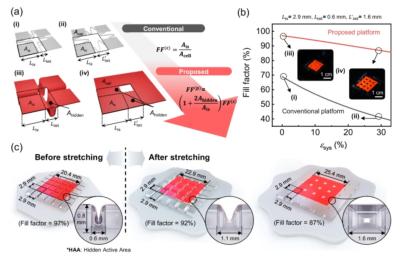Researchers from Korea's KAIST, ETRI, and Dong-A University propose a new stretchable OLED display architecture, based on a 3D form that includes hidden sections that act both as active emitting areas and interconnectors. The idea is that as the OLED display is stretched, these areas pop into place and add to the emitting area of the OLED. The areas are basically hidden pixels that are only used when the display stretches.
To create this OLED device, the researchers attached ultrathin OLED films to a 3D rigid island array structure through quadaxial stretching, enabling precise, deformation-free alignment. The researchers explain that a portion of the ultrathin OLED is concealed by letting it ‘fold in’ between the adjacent islands in the initial, non-stretched condition and gradually surfaces to the top upon stretching.
This design enables stretchable OLED displays that perform well even after after substantial deformation corresponding to a 30% biaxial system strain. The researchers fabricated passive-matrix OLED displays that utilize this architecture which are shown to be configurable for compensation of post-stretch resolution loss, demonstrating the efficacy of the proposed approach in realizing the full potential of stretchable OLEDs.
This is a very nice design. It's not clear how viable this is for mass production, though.


